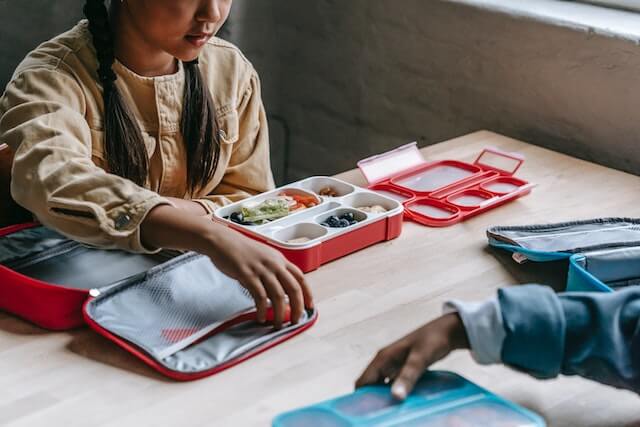Back to school can be a stressful time for all students, but especially for those with ADHD.
The shift from summer vacation to a new school year is abrupt and filled with uncertainty. With new teachers, classrooms, and routines, there are a lot of unknowns. And for children with ADHD, that uncertainty can breed anxiety.
But back-to-school time doesn’t need to be something to dread. With the right planning and prep, you can ease back-to-school fears and smooth out the transition – for ADHD students and parents.
So read on for 10 back-to-school tips for ADHD that’ll help set the school year up for success:
1 – Set Goals
Setting goals sets the tone for the new school year and helps your child reflect on what’s important to them. Talk about their strengths and areas of improvement. Then help them create goals based on their responses.
It could be turning homework in on time, getting a good behavior report, or making new friends. Whatever they choose, be sure the goal is clear and achievable.
When it comes to goals, a little motivation goes a long way. So once goals are set, brainstorm rewards to celebrate when a goal is met. It could be extra screen time, a playdate, or even a special outing.
2 – Get Clear on Routines
Transitioning from the freedom of summer to the structure of school days can be quite the shock. Having clear routines can make all the difference for your children and for you!
Setting up routines ahead of time prevents morning mayhem and helps start the day off right. Have a family meeting and map out your morning, after-school, and evening routines.
Get your children involved, so they feel invested in the routines. Be sure to post a visual schedule of routines, so your child knows what to expect.
When planning routines, aim to do as much as possible the night before, so mornings run smoother. Some evening to-dos may include picking out clothes and packing lunches and backpacks.
Once routines are set, try a practice run before the big day. This’ll help work out any kinks so you can make adjustments as needed.

3 – Create a “Launch Pad”
Getting out the door on time can be challenging for kids with ADHD. Between backpacks, lunch bags, homework, and books, there’s a lot to remember! But there’s a secret weapon that can cure the morning chaos and start the day off right: having a “launch pad.”
A launch pad is a designated space, typically by your front entrance, that has all “out the door” items. It can be as simple as a small table or a shelf on a bookcase (you can find plenty of inspiration on Pinterest). Find what works best for you.
Whatever launch pad you choose, give each child their own bin, basket, or crate to house all their morning essentials. Have your child prep their launch pad the night before. That way, in the morning, they can just grab and go!
4 – Keep a Calendar
Organization is often a struggle for kiddos with ADHD. So to help them stay on top of things, post a family calendar.
Having a monthly calendar helps keep track of all upcoming school events, sports practices, after-school activities, and project due dates. Post the calendar somewhere everyone can see it (like the fridge) and refer to it daily.
Kids with ADHD thrive with predictability. Ask your child questions about what’s coming up on the calendar, so they know what’s going on. Knowing what to expect eases anxiety and gives children with ADHD a sense of control.
5 – Set up a Study Space
Children with ADHD are bombarded with distractions at school. So do what you can to create a peaceful learning space at home.

Choose a study area where there are minimal distractions. It could be the kitchen table, a desk in a common area, or even parked on the couch with a lap desk or clipboard. Experiment and find what works best for your child.
If you have several children, spread them out to prevent distractions. Or, if they’re using a shared space, consider using desk dividers to help them stay focused. Since children with ADHD have attention issues, be sure you’re in earshot so you can help keep them on track.
Many children with ADHD are run ragged by the end of the school day. So when you get home, consider giving them some time to chill and reset. A little goes a long way; even 10-15 minutes will do.
Also, be sure to give breaks often when working on schoolwork. For school-aged kids, aim to take a break every 15-20 minutes. For teens, every 30 minutes is a good place to start.
Having supplies tidy and organized can also make homework time more efficient. So consider creating a homework caddy to keep supplies handy.
6 – Meet with Your Child’s Teacher
If possible, set up a meeting with your child’s teacher before the first day of school. Discuss your child’s history, their ADHD, and what strategies worked well last year. This is also a great time to review any 504 accommodations or IEP goals so you can get a plan in place.
Get a communication plan so you stay in the know about behavior, upcoming assignments, and school events. Find out how you can support your child’s teacher to help make this year a success.
Plan to check in after the first week to see how things are going and keep the lines of communication open.

7 – Celebrate Wins (Big & Small)
Children with ADHD (and all children, for that matter) thrive on positive reinforcement. So be sure you’re dishing out plenty of encouragement when things go well.
Celebrate all wins, both big and small. It could be a good behavior report, turning their homework in on time, passing a test, or simply getting to bed on time. Do your best to catch your child being good as often as possible, and offer plenty of praise.
8 – Get Back on a Sleep Schedule
Summertime throws off sleep schedules. Kids stay up later and sleep in longer, which can make back-to-school time a rude awakening (pun intended). If your children have been sleeping at odd hours, it takes time for their bodies to adjust.
So try gradually getting your kids to bed earlier in the weeks leading up to school. Studies show that getting quality sleep can help reduce ADHD symptoms.[1] So practicing good sleep hygiene is crucial all year long.
9 – Get Exercise
When planning after-school activities, consider getting some exercise in the mix. This could mean joining a sports club, going for a bike ride, or taking a study break to jump on the trampoline.
Research shows exercise helps with depression, anxiety, aggressive behaviors, and social problems in children with ADHD.[2] In one study, children took part in an exercise program for 11 weeks. Both parents and teachers reported fewer ADHD symptoms in children who participated.[3]
Physical movement can also help kids with ADHD burn off any anxious energy about returning to school. So be sure to set aside time for them to get their body moving!
10 – Plan Healthy Meals
Before school starts, plan out a weekly meal plan of nutritious meals and snacks. An ADHD-friendly diet includes plenty of fruits, vegetables, whole grains, healthy fats, and protein.

Protein is the key – as it prevents blood sugar spikes that can aggravate ADHD symptoms. So plan for some protein at every meal and snack. Limit sugar, simple carbs, and artificial additives as much as possible, as they may trigger symptoms.
Breakfast is especially important, as it provides fuel for the day. Some nutritious, protein-filled breakfast ideas include:
- Scrambled eggs with toast
- Yogurt parfait with fruit and nuts
- Oatmeal with peanut butter and banana
For extra help, consider adding in some targeted nutritional support. Certain nutrients support healthy cognitive function and help improve focus, mental clarity, and alertness.
[1] https://pubmed.ncbi.nlm.nih.gov/27614815/


